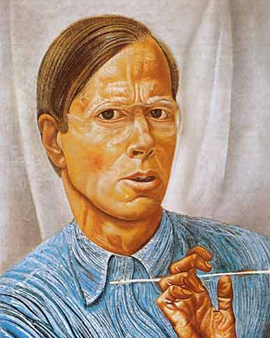


Boris Dmitrievich Grigorjev was a Russian painter and poet. He was born in Rybinsk in the summer of 1886. The city is located at the mouth of the Volga, 280 kilometers north of Moscow. After graduating from high school, Boris moved to Moscow to study at the art academy. After a few years he transferred to the Imperial Academy of Arts in St. Petersburg, where he continued his studies. The St. Petersburg Academy of Arts was founded in 1757 by Ivan Ivanovich Shuvalov, a Russian count. He was an important representative of the Enlightenment and was largely responsible for the founding of the Moscow University. During his studies Grigoriev attended many courses with famous Russian painters, graphic artists and illustrators such as Kardovsky, Archipov or Kiselyov, who always influenced the work of the young painter.
After his studies Grigoryev moved to Europe. He spent some time in Paris, where he attended courses at the Académie de la Grande Chaumière. The Paris Academy of Arts is still located in the 6th arrondissement and was founded by two women, the Swiss Martha Stettler and her Baltic friend Alice Dannenberg. A peculiarity in those days, because at the beginning of the 20th century it was not yet common for women to run companies, academies or schools. In 1913 Boris Grigoriev returned to Saint Petersburg. It was the time of bohemianism. Grigoriev joined the artists' group "Mir Iskusstwa". The association was founded by Sergei Djagilew and had a decisive influence on the cultural life in Russia at the beginning of the 20th century. In the artist group he developed his passion for literature. The members encourage him. Thus, in addition to new paintings, he also writes his first novel. The title was "Young Rays". It found an enthusiastic readership among his intellectual friends.
From 1916 to 1918 Grigoriev painted a series of pictures about the Russian rural population. In his pictures he focused on the sometimes great poverty of the people, but also on the strength of Russian agriculture. The well-known art critic Alexander Benois commented on the picture series with the written words: "He impressively depicts the essence of Russia before the revolution in an artistic way. Boris Grigorjev then took up his first teaching position at the "First State Free Art Workshop" in Moscow. However, he very quickly encountered resistance from his students. They were dissatisfied with Grigorjev's performance and dismissed the painter. The students were members of a new movement called "Group without teachers", which wanted to take more responsibility for their own education. Grigorjev finished his teaching assignment and moved to Europe, where he lived again in France, but also in Germany and Finland. He then travels through North and South America. He continues to process new impressions in paintings, but also writes texts and novels. He died in winter 1939 in Cagnes-sur-Mer, France.

Boris Dmitrievich Grigorjev was a Russian painter and poet. He was born in Rybinsk in the summer of 1886. The city is located at the mouth of the Volga, 280 kilometers north of Moscow. After graduating from high school, Boris moved to Moscow to study at the art academy. After a few years he transferred to the Imperial Academy of Arts in St. Petersburg, where he continued his studies. The St. Petersburg Academy of Arts was founded in 1757 by Ivan Ivanovich Shuvalov, a Russian count. He was an important representative of the Enlightenment and was largely responsible for the founding of the Moscow University. During his studies Grigoriev attended many courses with famous Russian painters, graphic artists and illustrators such as Kardovsky, Archipov or Kiselyov, who always influenced the work of the young painter.
After his studies Grigoryev moved to Europe. He spent some time in Paris, where he attended courses at the Académie de la Grande Chaumière. The Paris Academy of Arts is still located in the 6th arrondissement and was founded by two women, the Swiss Martha Stettler and her Baltic friend Alice Dannenberg. A peculiarity in those days, because at the beginning of the 20th century it was not yet common for women to run companies, academies or schools. In 1913 Boris Grigoriev returned to Saint Petersburg. It was the time of bohemianism. Grigoriev joined the artists' group "Mir Iskusstwa". The association was founded by Sergei Djagilew and had a decisive influence on the cultural life in Russia at the beginning of the 20th century. In the artist group he developed his passion for literature. The members encourage him. Thus, in addition to new paintings, he also writes his first novel. The title was "Young Rays". It found an enthusiastic readership among his intellectual friends.
From 1916 to 1918 Grigoriev painted a series of pictures about the Russian rural population. In his pictures he focused on the sometimes great poverty of the people, but also on the strength of Russian agriculture. The well-known art critic Alexander Benois commented on the picture series with the written words: "He impressively depicts the essence of Russia before the revolution in an artistic way. Boris Grigorjev then took up his first teaching position at the "First State Free Art Workshop" in Moscow. However, he very quickly encountered resistance from his students. They were dissatisfied with Grigorjev's performance and dismissed the painter. The students were members of a new movement called "Group without teachers", which wanted to take more responsibility for their own education. Grigorjev finished his teaching assignment and moved to Europe, where he lived again in France, but also in Germany and Finland. He then travels through North and South America. He continues to process new impressions in paintings, but also writes texts and novels. He died in winter 1939 in Cagnes-sur-Mer, France.
Page 1 / 2






